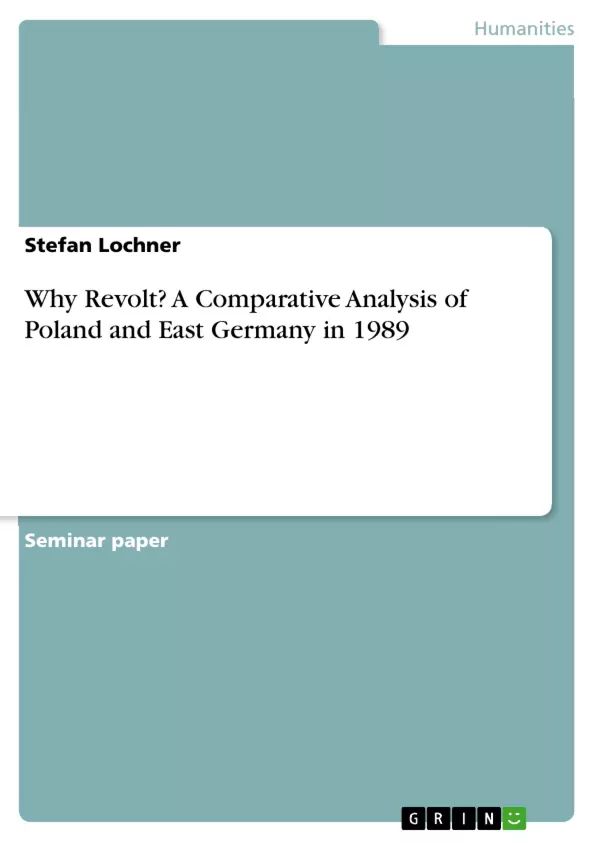The collapse of communism at the end of the 1980s was one of the most important occurrence in the 20th century. In only a few months – starting with the institutional compromises in Poland and Hungary and the non-violent revolutions in the GDR and ČSSR - the Soviet-led East European statesystem and later the Soviet Union as well, dispersed in a way and with such rapidy, nobody in the “West” and “East” believed to be possible. Real self-determination of the satellite states or indepenence of the former Soviet Republics and changes in the political and economic system were the consequences. At the highest historic level, the world´s geopolitical order changed dramatically, because the devision into two fields of interest was brought to an end and with it the Cold War. From a European perspective, after the downfall of the “Iron Curtain” the opportunity was opened to fulfill the idea of a European Community, also in a much wider sense, and for Germany the over 40 year lasting existence of two states was repealed with the reunification.
In the following passage of the main part I will try to explain why in Poland an institutional compromise was achieved, whereas in East Germany a non-violent revolution broke out. With references to Poland, we can speak of an institutional compromise because the “impetus for change came from the elite, which undertook negotiations with the opposition over the shape of the new institutions”, while in East Germany a revolution took place because “the impetus for change came directly from the mobilization of a broad-based opposition engaged in non-accepted means of mass collective action; the result was systematic change in both the political and the socioeconimoc system”.
Inhaltsverzeichnis (Table of Contents)
- I. Introduction
- II. Method
- III. Theoretical Discussion
- IV. A Comparative Analysis of Poland and East Germany
- 4.1. Political Opportunity Structure: The Gorbachev Factor in Connection to a Framing Analysis
- V. Conclusion
Zielsetzung und Themenschwerpunkte (Objectives and Key Themes)
This paper aims to analyze the reasons behind the different political outcomes in Poland and East Germany in 1989, one characterized by an institutional compromise and the other by a non-violent revolution.- Comparative analysis of Poland and East Germany
- Role of the Gorbachev factor in political opportunity structure
- Impact of framing processes on public perception and mobilization
- Influence of economic crisis and political reform on government strategies
- Impact of Soviet Union's influence on domestic and foreign policy
Zusammenfassung der Kapitel (Chapter Summaries)
- Introduction: The paper sets the context for the analysis by highlighting the significance of the collapse of communism in Eastern Europe in the late 1980s. It establishes the focus of the study: to understand why Poland achieved an institutional compromise while East Germany witnessed a non-violent revolution.
- Method: The paper outlines its methodological approach, employing the macro-causal type of analysis based on John Stuart Mill's Method of Difference. The goal is to explain the different outcomes in Poland and East Germany by identifying crucial variables.
- Theoretical Discussion: The paper presents the theoretical frameworks used for the analysis: the political opportunity structure approach and framing analysis. These approaches are chosen for their focus on both "structure" and "agency" in understanding macrosociological events.
- A Comparative Analysis of Poland and East Germany: This chapter begins the comparative analysis of the two countries, focusing on the political opportunity structure and the Gorbachev factor. It explores how Gorbachev's reforms in the Soviet Union, including “glasnost” and “perestroika,” created opportunities and influenced the political landscape in both Poland and East Germany.
Schlüsselwörter (Keywords)
This paper explores the dynamics of political change in Eastern Europe through the lens of political opportunity structure, framing analysis, and the impact of Gorbachev's reforms. Key concepts include institutional compromise, non-violent revolution, comparative analysis, political opportunity structure, framing processes, and the Gorbachev factor. The analysis focuses on the unique circumstances and responses of Poland and East Germany within the broader context of the collapse of communism.- Arbeit zitieren
- Stefan Lochner (Autor:in), 2004, Why Revolt? A Comparative Analysis of Poland and East Germany in 1989, München, GRIN Verlag, https://www.grin.com/document/180362



